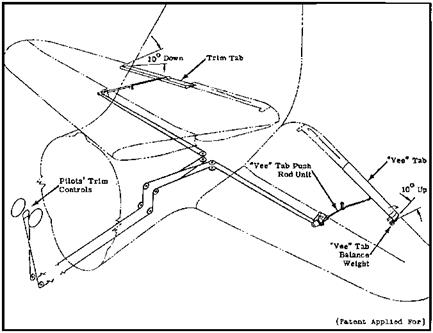Springy Tabs and Downsprings
Sometimes called “Vee” tabs, springy tabs first appeared on the Curtiss C-46 Commando twin-engine transport airplane. Their inventor, Roland J. White, used the springy tab to increase the C-46’s allowable aft center of gravity travel. White was a Cal Tech classmate of another noted stability and control figure, the late L. Eugene Root. Springy tabs increase in a stable direction the variation of stick force with airspeed. A springy tab moves in one direction, with the trailing edge upward. It is freely hinged and is pushed from neutral in the trailing-edge-upward direction by a compression spring (Figure 5.15). An NACA application mounted the springy tab on flexure pivots.
The springy tab principle of operation is that large upward tab angles are obtained at low airspeeds, where the aerodynamic moment of the tab about its own hinge line is low compared with the force of the compression spring. Upward tab angle creates trailing-edge – down elevator hinge moment, which must be resisted by the pilot with a pull force. Pull force at low airspeed is required for stick-free stability.
The C-46 springy tabs were called Vee tabs because the no-load-up deflection was balanced aerodynamically by the same down rig angle on a trim tab on the opposite elevator (Figure 5.15). The C-46 springy tabs were also geared in the conventional sense. The compression spring that operated the C-46’s springy tab was a low-rate or long-travel spring with a considerable preload of 52 pounds. Tab deflection occurred only after the preload was exceeded, making the system somewhat nonlinear.
|
Figure 5.15 Schematic diagram of the elevator trim and vee-tab installations on the Curtiss C-46 Commando. The vee tab augments static longitudinal stick-free stability. (From Rumph and White, Curtiss Rept. 20-Y48, 1945) |
Springy tabs were also used successfully on the Lockheed Electra turboprop. Although White is considered the springy tab’s inventor and was the applicant for a patent on the device, it may have been invented independently by the late C. Desmond Pengelly. Springy tabs are not in common use currently because of potential flutter. Irreversible tab drives are preferred to freely hinged tabs from a flutter standpoint.
A flutter-conservative means of accomplishing the same effect as a springy tab is the downspring. This is a long-travel spring connected between the elevator linkage and airplane fixed structure. The stick or yoke is pulled forward by the long-travel spring with an essentially constant force. Elevator aerodynamic hinge moment, which would normally fair the elevator to the stabilizer, is low compared with the spring force, and the pilot is obliged to use pull force to hold the elevator at the angle required for trim. As with the springy tab, this provides artificial stick-free stability. Downsprings are often found in light airplanes. If the yoke rests against its forward stop with the airplane parked, and a pull force is needed to neutralize yoke travel, either a downspring is installed or, less likely, the elevator has mass unbalance.














